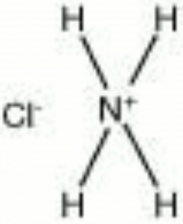Difference between revisions of "Ammonium chloride"
m (Text replace - "== Authority ==" to "== Sources Checked for Data in Record ==") |
|||
| Line 46: | Line 46: | ||
[http://www.cdc.gov/niosh/ipcsneng/neng1051.html International Chemical Safety Card] | [http://www.cdc.gov/niosh/ipcsneng/neng1051.html International Chemical Safety Card] | ||
| − | == | + | == Sources Checked for Data in Record == |
* R. J. Gettens, G.L. Stout, ''Painting Materials, A Short Encyclopaedia'', Dover Publications, New York, 1966 | * R. J. Gettens, G.L. Stout, ''Painting Materials, A Short Encyclopaedia'', Dover Publications, New York, 1966 | ||
Revision as of 12:31, 29 April 2016
Description
Slightly hygroscopic white crystals historically used to separate Gold from Silver or Copper. Ammonium chloride was known in ancient times where legend tells it was observed in the Temple of Zeus-Ammon in Egypt as it was scraped from the ceiling after camel dung was burned. Ammoniun chloride has also been used as a Mordant, as a textile finishing agent to produce luster and as a tanning agent for Leather. Currently, the most common uses for ammonium chloride are as a soldering flux for Iron, as a component in galvanizing solutions, as an electrolyte in dry cells and as a metal coloring agent.
Synonyms and Related Terms
sal ammonia; sal ammoniac; sal ammoniacum; ammonium muriate; salmiak (Ces.); chlorid amonný (Ces.); ammoniumklorid (Dan., Sven.); Ammoniumchlorid (Deut.); cloruro di ammonio (It.); salmiakzout (Ned.); chlorek amonu (Pol.); nashadir (Arab.); naosha (Chin.); nao sadar (India); salmiac; Amchlor; Darammon
Other Properties
Soluble in water, methanol, ethanol. Insoluble in acetone, ether, ethyl acetate. Incompatible with alkalis and lead or silver salts.
Crystals form aggregates with conchoidal fracture.
| Composition | NH4Cl |
|---|---|
| CAS | 12125-02-9 |
| Mohs Hardness | 1.0 - 2.0 |
| Melting Point | 340-350 (sublimes) |
| Density | 1.5274 |
| Molecular Weight | mol. wt. = 53.5 |
| Refractive Index | 1.639 |
| Boiling Point | 520 |
Hazards and Safety
International Chemical Safety Card
Sources Checked for Data in Record
- R. J. Gettens, G.L. Stout, Painting Materials, A Short Encyclopaedia, Dover Publications, New York, 1966
- Dictionary of Building Preservation, Ward Bucher, ed., John Wiley & Sons, Inc., New York City, 1996
- G.S.Brady, Materials Handbook, McGraw-Hill Book Co., New York, 1971 Comment: p. 58
- Richard S. Lewis, Hawley's Condensed Chemical Dictionary, Van Nostrand Reinhold, New York, 10th ed., 1993
- Van Nostrand's Scientific Encyclopedia, Douglas M. Considine (ed.), Van Nostrand Reinhold, New York, 1976
- The Merck Index, Martha Windholz (ed.), Merck Research Labs, Rahway NJ, 10th edition, 1983
- Encyclopedia Britannica, http://www.britannica.com Comment: "Ammonium chloride" Encyclopædia Britannica Premium Service. [Accessed 25 Jan. 2003].
- Random House, Webster's Encyclopedic Unabridged Dictionary of the English Language, Grammercy Book, New York, 1997
- The American Heritage Dictionary or Encarta, via Microsoft Bookshelf 98, Microsoft Corp., 1998
- Wikipedia, the free encyclopedia, at http://www.wikipedia.com Comment: http://en.wikipedia.org/wiki/Ammonium_chloride (Accessed Mar. 20, 2006) -for non-English terms
- Michael McCann, Artist Beware, Watson-Guptill Publications, New York City, 1979
- Susan E. Schur, Conservation Terminology: A review of Past & Current Nomenclature of Materials, Technology and Conservation, Spring (p.34-39); Summer (p.35-38); Fall (p.25-36), 1985
